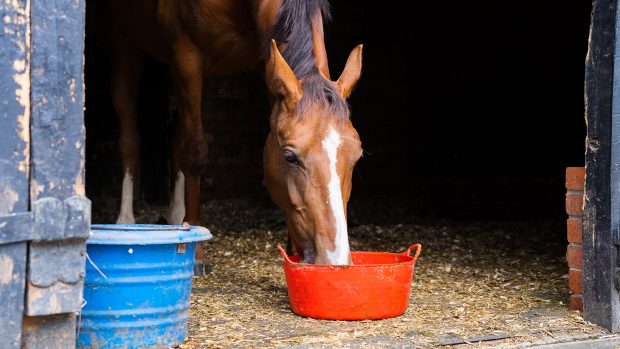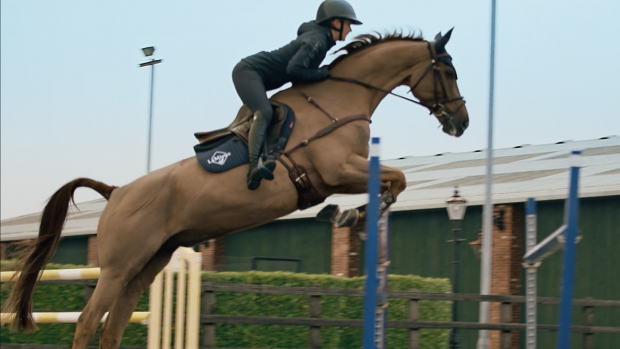Why do horses competing and training at a high level require more protein in their diet?
When horses are competing or training intensively, they need to be provided with a balanced diet that combines adequate forage with a suitable level of energy which reflects their workload. Most competition or performance feeds will provide sufficient digestible energy in the form of fats and carbohydrates (between 12-14MJ/kg) and a suitable level and balance of vitamins and minerals. However, ensuring that your horse has the correct quality and quantity of protein in their diet is not quite so straightforward.
Proteins are molecules found in every cell in the body, and perform an enormous range of roles – hormones, enzymes, nerve transmitters, hair, DNA, cell receptors, tendons, cartilage and muscle to name but a few. Despite this great complexity, every protein in your horse’s body is made up of an “alphabet” of just twenty-one building blocks called amino acids. Although your horse is able to make some of these amino acids within their body, the remainder are called essential amino acids, and have to be supplied in their diet. Any deficiency in these essential amino acids can limit protein production in the body.
Horses in work have increased protein requirements. This is because amino acids are intimately involved in tissue growth and repair, and when your horse is in hard work, the rate of turnover of tissue protein, i.e. breakdown and re-growth, is increased.
Dietary protein sources are not all the same – they all contain varying levels and amounts of the twenty one different amino acids. Protein sources are described as being of a higher quality or biological value when they are able to provide your horse with a greater level of these essential amino acids.
Exercise increases the need for quality dietary protein
As outlined above, amino acids are the raw ingredients or building blocks for the structural protein found in all body tissues and importantly, muscle and blood components e.g. haemoglobin. Your horse’s body is in a constant state of turnover (breakdown and repair) and amino acids are always required to renew, repair and replace both structural tissue protein and other protein-containing substances such as hormones, enzymes and neurotransmitters. Whilst your horse is undertaking regular exercise and competition, the turnover of muscle-related protein happens at a faster rate. This means that the requirement for amino acids from the diet is increased and the harder the exercise the greater is the need. If your horse is young and still growing, the need for dietary protein is further increased. This is because the amino acids are needed to support the tissue development involved in growth.
Another important role of amino acids in the working horse is associated with the replenishment of energy stores. Horses maintain an important store of carbohydrate in their liver and muscles, which is used up during exercise, and therefore must be replenished following hard work, racing or competition. Some amino acids help with the replenishment of these stores of carbohydrate following exercise. This means that your horse must have an adequate level of good quality protein in their diet even during recovery from a hard day’s exercise, race or competition.
Exercise training involves a cycle of damage and repair to tissues
When your horse is being exercised regularly their body adapts to ensure that energy production, muscle contraction and oxygen transport around the body becomes more efficient and that bones, ligaments, tendons and joints become stronger. This process involves a cycle of low level damage to different tissues in response to the stress of exercise. In response to this, your horse’s body will go through a natural healing or repair process. A good training programme will support this cycle of micro-damage and repair by:
- Tailoring exercise to prevent over exertion – to reduce the risk of injury.
- Allowing your horse enough days of light exercise or no exercise – to allow the process of recovery and repair to take place.
- Making sure that their diet provides all the essential nutrients required including amino acids, trace minerals, vitamins etc – to support the ongoing repair processes.
If you overtrain your horse, the rate of tissue micro-damage becomes greater than the maximum rate of repair. This can cause horses to seem less willing to work and/or more susceptible to infection. This ultimately means that you may notice a decrease in your horse’s performance over time and your training programme and diet should perhaps be re-evaluated. Amino acids are essential for the tissue repair process, therefore it is vital that your horse’s diet delivers an optimum level of amino acids to help ensure that the repair process can keep up with the level of micro-damage.
Horses can only utilise protein digested in the small intestine
The digestion of dietary protein, which results in the release of amino acids for tissue growth and repair, occurs in the small intestine. Certain enzymes, only present in the small intestine, are needed to break up the complicated structure of protein in feed to a level where it can be absorbed.
The protein that is found in forage (hay or haylage) is not very digestible in the small intestine. This means that on a high forage diet, your horse’s intake of essential and non-essential amino acids can be limited. If your horse is being fed a traditional competition or performance ration, it is likely that they are relying on cereals such as oats and barley, perhaps in combination with high fibre ingredients and oil. Whilst this balance of ingredients may satisfy the need for energy and total protein, the balance of amino acids (essential and non-essential) that they provide is not ideal. This means that your horse’s competition or performance rations could be improved by adding ingredients that offer higher quality protein.
Equitop Myoplast: a quality source of highly digestible amino acids
Equitop Myoplast provides your horse with both essential and non-essential amino acids (see table 1). In addition to supporting the development and repair of muscle tissue, some of the amino acids in Equitop Myoplast (leucine, isoleucine and valine) have been shown to slow the process of what’s termed central fatigue during exercise. Central fatigue is the process by which your horse’s brain influences the ‘desire’ to continue to exercise and is thought to influence the ‘will to win’ phenomenon in horses.
Table 1 – amino acid composition of commonly used feed sources (oats and barley) and Equitop Myoplast.
* Note that some high energy feedstuffs such as oats or barley can be low in calcium. So if you are feeding straight feed ingredients remember that a vitamin and mineral supplement may be required.
Equitop Myoplast also provides a readily available source of iron, which is a trace mineral essential for the formation of both haemoglobin and myoglobin. These two substances are involved in the transport of oxygen within muscles and around the body are vital for horses in hard work.
Dietary protein therefore has a critical role to play in maintaining the balance between the tissue damage and repair processes that your horse will be subject to during training. Providing an additional source of protein that is very digestible in the small intestine and that delivers a superior profile of amino acids such as Equitop Myoplast can be potentially beneficial to ongoing performance.
Advice on the use of Equitop Myoplast or other therapies should be sought from your veterinary surgeon. Further information available from Boehringer Ingelheim Vetmedica, Bracknell, Berkshire, RG12 8YS, UK. Email: vetmedica.uk@boehringer-ingelheim.com. This is not a veterinary medicine which is subject to authorisation by the Irish Medicines Board. Date of preparation: August 2010. AHD 6442




